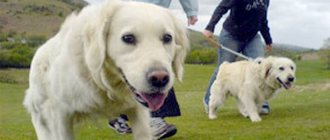Yorkshire Terriers are among the most popular pets. And this is not surprising!
These miniature dogs are prone to empathy and always know how to cheer up their owner. They are very friendly and easily get along with everyone in the household, including other animals.
Despite their small size, Yorkies consider themselves real home guards . If something seems suspicious or hostile to the dog, he will immediately notify the owners about it with his ringing bark.
Normal indicators
Normally, a dog's body temperature should be between 37.3°C and 39.3°C. This range is very different from the human range, so don't panic after first looking at the thermometer. The indicator is individual for each pet. The value depends on several factors:
- breed affiliation;
- physiological state of the body;
- age;
- body size.
Physiological changes associated with bearing offspring are characteristic of females. In older animals, fluctuations of several degrees during the day are acceptable. In other cases, the fluctuation is no more than 0.5°C. If you remain in good health and there are no other alarming symptoms, a visit to the veterinary clinic is not necessary.
First of all, you need to figure out what temperature a large, medium or small breed dog should have. Separately, the dependence on age is touched upon.
In large breeds
The larger the animal, the lower its temperature indicators. This is due to the speed of metabolic processes. Small breed dogs have a fast metabolism. The energy released by the body directly affects the thermometer scale.
Normal body temperature in large breed dogs is 37.3-38.5°C. This group includes animals heavier than 28 kg and higher than 60 cm at the withers. These include:
- Labradors and golden retrievers;
- Rottweilers;
- Great Danes;
- German Shepherds;
- Saint Bernards;
- mastiffs;
- Dalmatians;
- Newfoundlands;
- Dobermans.
The indicated temperature is the norm for adult dogs. Indicators for puppies will be discussed below.
In medium breeds
The normal body temperature of medium-sized dogs is 37.6-39°C. This group includes animals weighing 10-28 kg and height 40-60 cm. These include:
- Border Collie;
- cocker spaniels;
- Siberian Huskies;
- boxers;
- Shar-Pei;
- Sheltie;
- chow-chow;
- Australian Shepherds;
- pit bull terriers;
- West Siberian huskies.
Pay attention to interbreed differences. Pets belonging to different breeds will have different temperature readings.
In small breeds
The normal temperature for small breed dogs is 38.4-39.3°C. This group includes animals weighing less than 10 kg and height less than 40 cm. These include:
- Pomeranians;
- Yorkies;
- toy terriers;
- chihuahua;
- pugs;
- lap dogs;
- dachshunds;
- Pekingese;
- Chinese Crested;
- Shih Tzu.
The maximum value is typical for Chihuahuas. For them, as well as for Yorkshire terriers, the upper limit reaches 39°C.
In puppies
A puppy's normal temperature is 37.5-39°C. Minimum values are typical for newborns. They are only 33-36°C. After the 20th day from birth, the puppy’s temperature returns to normal.
Puppies of any breed have a fast metabolism. Their temperature readings are always higher than those of older dogs.
How to tell if your pet is sick: first signs and symptoms
An increase in body temperature is a clear signal that the body is fighting the disease.
Unfortunately, our smaller brothers cannot speak, which means that the responsibility for their health lies entirely with us, their owners. It is the owner who needs to understand that the pet is sick. It is impossible to say for sure whether a pet is sick or not. To do this, you need to pay attention to the symptoms.
Increased eye irritation and nasal discharge are signs of a cold.
- Touch your nose.
- You need to take your temperature. We have already talked about the norm above.
- Pay attention to the dog's fur.
- Snot and lacrimation.
- Refusal to eat, but at the same time the manifestation of increased thirst. If your pet does not want to try even his favorite treat, then this sign, together with the above, also indicates that the dog is sick and needs diagnosis and treatment.
- Lethargy. Lethargy and passivity of the dog is another symptom that the dog has started to get sick.
Intense heat deprives the dog of strength, because the body has devoted all its strength to fighting the virus.
Symptoms of deviation from the norm
Dogs' body temperature decreases by 0.2-0.6°C during sleep. This is due to the suspension of metabolic processes. In other cases, deviation from the norm is referred to as hyperthermia or hypothermia.
With hyperthermia, the mercury thermometer rises. In most cases, “warming” plays a protective role: in this way the body tries to destroy pathogenic microorganisms. Associated symptoms include:
- loss of activity and appetite;
- fever or chills;
- gastrointestinal upset (diarrhea, nausea);
- hot and dry nose;
- strong thirst.
Hypothermia is considered a more dangerous condition. It is characterized by cooling of the body to 32°C. In the most severe form, the value drops below 28°C. The risk group includes newborn puppies and older dogs. Associated symptoms include:
- weakness and drowsiness;
- dilated pupils with loss of reaction to light;
- weak breathing;
- refusal to execute commands;
- involuntary muscle contractions;
- a sharp decrease in blood pressure and heart rate.
If the thermometer shows less than 28°C, contact the veterinary clinic immediately. This condition is fraught with deep coma and death of the animal.
Retinal dysplasia
An abnormality in the development of the retina or dysplasia is a hereditary process that leads to a decrease in visual acuity or its complete loss. Indirect signs of the disease, noticeable at an early stage of its development:
- constantly dilated pupils;
- decreased vision at dusk;
- gray glow of the fundus.
Only an ophthalmologist can accurately diagnose the pathology based on an ophthalmoscopy.
How to measure a dog's temperature
You can measure your dog's body temperature with a mercury or electronic thermometer.
In both cases, measurements are taken rectally. The advantage of an electronic thermometer is its high measurement speed, which is only 30-40 seconds. Before purchasing a measuring device, make sure that it was made in Russia. Otherwise, there is a high probability of indicators in Fahrenheit, and not in the usual Celsius.
With a thermometer
A mercury thermometer provides more accurate readings, but it is easier to damage. Due to possible mercury vapor poisoning, it is safer to use electronic analogues. If you only know how to measure a dog’s body temperature in theory, buy an electronic thermometer.
The measurement scheme does not depend on age, so the following steps apply to any pet:
- Prepare the thermometer by lubricating the tip with oil or petroleum jelly for easier insertion.
- Calm the animal. Pet him and give him his favorite treat.
- Lay the dog on its side and secure it in this position.
- Lift the tail and gently insert the instrument into the anus. The insertion depth depends on the size: 1.5-2.5 cm - for large representatives, 1-1.5 cm - for small ones, less than 1 cm - for puppies.
- During the procedure, distract your pet by talking or stroking.
- At the end of the required time, take out a thermometer, wipe it with cotton wool and record what the dog’s temperature is displayed on the display.
- Wash the thermometer with soap and warm water and disinfect with alcohol.
It is recommended to take measurements from childhood. Act calmly and confidently so as not to scare your pet. If this is your first time, ask someone in your household to help you.
Without a thermometer
Measurements without a thermometer are less accurate, but sometimes they are the only way to detect temperature changes. Veterinarians recommend periodically palpating your pet's ears and paws. These organs have a large number of blood vessels.
When the dog's normal body temperature rises, more heat is generated and felt when touched. In addition to paws and ears, the nose is an informative source. When it's hot, it becomes dry and hot.
If the body is affected by an infection, it can be easily identified by enlarged lymph nodes in the armpits and groin area. Carefully feel these places. When fighting an infection, the nodes become inflamed and hot to the touch.
A drop in temperature below normal in dogs is more difficult to track. Here you will have to rely only on the accompanying symptoms, including apathy and muscle tremors.
Description of the breed
Yorkshire Terriers were originally considered rat-catching dogs. They were bred like cats in order to rid peasant farms of rodents and other pests, which these small and nimble dogs did an excellent job with. Only after a while, the cute appearance of dogs of this breed was noticed in social circles and they began to have them as a companion.
There is no undercoat under the Yorkie's smooth and silky coat, which is why representatives of this breed are very sensitive to low temperatures and can easily become hypothermic. In terms of health, Yorkies are delicate and fragile. Therefore, it is very important to monitor the well-being of your Yorkshire Terrier.
Causes of hypothermia and hyperthermia
Possible causes of deviations from the norm are divided into 2 types: pathological and physiological. The former require the mandatory intervention of a veterinarian, the latter go away on their own and do not have a detrimental effect on the body.
Possible diseases
Pathological causes of hypothermia include hypothermia, chronic liver and kidney diseases, food poisoning, helminthiasis, excessive blood loss due to fractures and other cases. Such conditions are characterized by severe weakening of the body and slowdown of vital processes.
Most often, hyperthermia is a consequence of the body’s fight against an invading infection. These may be viruses, parasites or bacteria. Other causes include acute poisoning, allergic reactions, disruption of the endocrine system, cancer and cardiovascular diseases.
Physiological (non-hazardous) reasons
Hypothermia occurs due to impaired heat production. This happens after lengthy operations on the thoracic or abdominal area under strong anesthesia. This is a natural reaction of the body after surgery. Monitor your operated pet carefully. He will be back to normal in a few days.
A similar situation occurs 8-14 hours before birth. Indicators drop to 36.7-37.7°C. After the birth of the puppies, the mother's condition returns to normal. If the number of degrees is less than the lower limit of the specified range, consult a doctor. This condition can be dangerous for the pet and her offspring.
Physiological causes of hyperthermia include:
- stress;
- change of baby teeth;
- intense physical activity associated with training or active games;
- recent feeding;
- heat;
- preventive vaccinations that involve fighting fragments of the virus;
- hot weather.
Hyperthermia is also acceptable immediately after childbirth. This is due to the arrival of milk. If the thermometer shows 39.8-40°C for more than a day, call a veterinarian.
Legg-Calvé-Perthes disease
Aseptic necrosis of the femoral head or Legg-Calvé-Perthes disease is a pathology that affects dogs aged 5-10 months. Symptoms in the form of pain when the hip is abducted to the side, muscle atrophy and lameness begin to appear at 3 - 5 months. Despite the heredity of this disease, the reasons for its development have not been precisely determined.
The main theory is that the blood supply to bone tissue is disrupted, which leads to its necrosis and resorption. This means that there is no inflammatory process during bone destruction. The diagnosis is made based on a series of x-rays of the hip joints, after which the doctor determines a treatment regimen.
First aid and treatment
If you do not have the opportunity to go to a veterinary clinic in the near future, arrange a comfortable place for your sick pet and provide him with first aid. Choose soft, comfortable bedding and place it away from drafts and noise. Avoid physical activity and place a bowl of clean water near the area.
Veterinarians recommend not to self-medicate. Antipyretic drugs from your home medicine cabinet can be toxic. The prohibited list includes Ibuprofen, Paracetamol and Aspirin. Taking these medications has a detrimental effect on the kidneys and liver, and also thins the blood. After such treatment, the animal may die.
An antipyretic is given strictly according to a prescription or after consulting with a doctor by phone, explaining what the dog’s temperature is and what could cause its deviation from the norm.
What to do if you have hyperthermia
To cool, use ice wrapped in thick cloth. Apply it to your ears and paw pads. Direct contact with ice is dangerous due to frostbite, so an additional layer is required.
If there is no ice, use cold water. Wet the described body parts immediately after drying. Additionally, it is recommended to place a damp towel on your forehead.
“
The pet should lie in a cool room, but not on a concrete floor. Give him cool water from a bowl. If the dog is too weak, wet his lips with a damp sponge.
After a few hours, check your dog's temperature. If there is no improvement, contact your veterinarian.
What to do if you have hypothermia
Actions during hypothermia are aimed at maintaining heat. Wrap the sick animal in a warm blanket. It can be heated with a hairdryer or held on a hot radiator. Place a heating pad or hot water bottle under a blanket or blanket. If you decide to use a bottle, be sure to wrap it in thick fabric so as not to burn the animal.
Provide constant access to warm water and warm liquid food. If the pet is unconscious, then it is better to refuse feeding.
All of the above actions are not treatment. Even if you feel better, it is recommended to contact a veterinary clinic. Puppies, elderly, pregnant and lactating animals are especially vulnerable.
Portosystemic shunt
Portosystemic (portocaval) shunts are a congenital pathology that occurs during intrauterine development. It is an abnormal vascular connection between the blood vessel connecting the gastrointestinal tract and the liver and the systemic circulation. With this anomaly, blood flow bypasses the liver, limiting its vital functions (metabolism, detoxification, protection against intestinal microorganisms) and exposing the pet’s body to toxic digestive products.
Symptoms:
- liver failure;
- toxicosis;
- weight loss;
- convulsions;
- vomit;
- growth stop.
For diagnosis, two samples (on an empty stomach and after a meal) of blood serum are examined for biochemical parameters, including total bile acids and ammonia. To eliminate the pathology, surgical intervention is necessary, in which an ameroid constrictor is placed on the vessel to compress it.
Worms
Helminths are dangerous for all dogs that do not undergo regular deworming. Signs of helminthiasis:
- diarrhea containing blood, mucus, and sometimes the worms themselves or their eggs;
- vomit;
- weight loss;
- the appearance of a rash, hair loss;
- blanching of mucous membranes;
- attempts to scratch the anus;
- bloated belly.
If parasites are present, it is necessary to undergo anthelmintic treatment, choosing a drug based on the age and weight of the pet. If worms are found in feces or vomit, self-deworming is prohibited due to the risk of blood contamination by parasite decay products.
Viral infections
| Disease | Symptoms | Forecasts |
| Parvovirus enteritis |
toxicosis. | The disease is characterized by a rapid course, death can occur 3-4 days after the first symptoms. Sometimes dogs manage to survive and develop immunity to this disease. |
| Rotavirus |
profuse diarrhea, vomiting with mucus. | The disease lasts no more than 1.5 weeks. The development of immunity is impossible due to the diversity of viruses of the Reoviridae group. With timely treatment and the absence of secondary infections, the prognosis is favorable. |
| Adenovirus: infectious hepatitis or adenovirus |
· damage to the central nervous system. | The pathology develops over several hours and most often leads to death. In case of recovery, the dog develops immunity for a long time. |
Yorkshire Terriers are dogs with a sensitive digestive system , which often reacts with diarrhea in response to any irritants.
Hydrocephalus of the brain
With this pathology, an excess of cerebrospinal fluid (CSF) is formed in the ventricles of the brain or the area of the meninges, due to which the nervous tissue is subjected to pressure and the dog’s vision decreases, the shape of the skull changes, and convulsions begin. The disease can occur suddenly or as a result of stress. Symptoms appear in puppies around 2 months of age and in older dogs. It is necessary to show your Yorkie to a veterinarian, who, after examination, will prescribe anti-inflammatory, diuretic and anti-shock medications.
Meningoencephalitis
| Meningoencephalitis (inflammation in the brain) | Description | Symptoms | Treatment |
| Necrotizing | A pathology characterized by multiple necrosis in the brain. Most often it affects the cerebral cortex, less often the brainstem. The disease has an acute onset and rapid progression. | Signs of the disease vary widely and depend on the size and location of the affected area. Most likely symptoms:
vomiting, diarrhea with blood. | Therapy depends on the cause of the disease. As a rule, a complex regimen of corticosteroids, antibiotics, immunomodulators, anticonvulsants and vitamins is prescribed. |
| Granulomatous | The causes of occurrence have not been established; it may have 1 or several foci, and also affect the optic nerve and the structure of the eyeball. |
Patella luxation
A hereditary pathology in which the position of the kneecap is displaced outward or inward relative to the normal position. Depending on the stage of the disease, the lameness characteristic of it can be constant or intermittent. Only an orthopedic doctor can diagnose the disease by examining the dog, assessing the nature of lameness and positioning of the limb, palpation and radiographs. Drug treatment gives a temporary effect, the main treatment is surgery.











